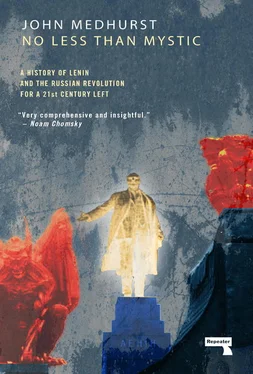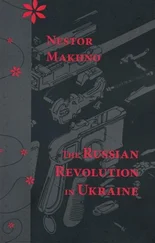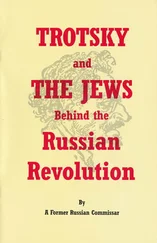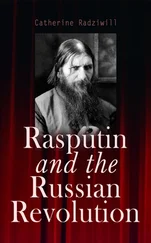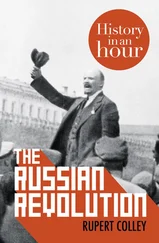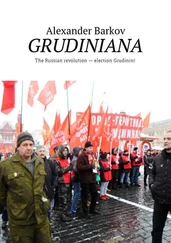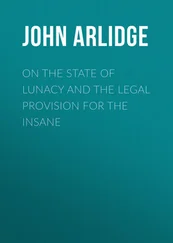John Medhurst
NO LESS THAN MYSTIC
A History of Lenin and the Russian Revolution for a 21st-Century Left
To my Mum and Dad and to the Isle of Dogs 1982-1988, where I learnt to argue about the Russian Revolution.
The Marxist doctrine is omnipotent because it is true
— V.I. Lenin,
The Three Component Parts of Marxism , 1914
No less than mystic is the concept of a political form that, by virtue of its particular character, can surmount all economic, social and national conditions
— Julius Martov,
The State and the Socialist Revolution , 1920
And Azrael, among scales of crippled wings,
threading his difficult way,
takes by its high art,
the defeated sky
— Osip Mandelstam,
Poems , 1922
INTRODUCTION
Because It’s True
The aim of this book is to present a history of Lenin and the Russian Revolution that is relevant to today’s democratic, libertarian left, especially those born since the fall of the Soviet Union. Although it broadly covers the period 1903 to 1921 and seeks to explain why the Bolshevik Revolution degenerated so quickly into its apparent opposite, it is not simply a work of history. It continually examines the Russian Revolution through the lens of a 21st-century, non-Marxist, participatory socialism, and draws parallels with recent anti-capitalist struggles, attempting to open up the past to the present and points in between. It suggests that corporate capitalism should be opposed not with a set of revolutionary formulations which were questionable one hundred years ago and have even less relevance now, but with popular social movements built on people’s needs and experience.
As a result, it is kinder to Russia’s non-Leninist socialists than are most histories. Although not blind to the many faults of the Russian Mensheviks, Socialist Revolutionaries and Jewish Bundists, I seek to rescue them from a century of disrespect. In doing so I do not assume the knowledge of the subject that many Russian Revolution hobbyists take for granted, nor show much deference to those icons of Bolshevism, Lenin and Trotsky, still common today on the left. In the end I suggest that anti-capitalist writers and campaigners such as Murray Bookchin, Noam Chomsky, Naomi Klein, Michael Lowy and Paul Mason have more constructive options to offer the left today than do the sages of Bolshevism.
Some will ask why, outside of academic history, this should be of any interest. The modern left does not look to the events of the French Revolution of 1789-95 for guidance, so why scrutinise and debate the Russian Revolution? The Russian Empire of the Romanov dynasty was a semi-feudal, multi-national monstrosity that collapsed as a result of total European war. We will not see that specific historical conjunction again. But for all that, the Bolshevik Revolution was still the first “modern” revolution–i.e. led by the urban working class and with a socialist objective–in an era dominated by global capitalism. As a result, it remains a key issue and point of contention from which subsequent arguments about capitalism and its alternatives derive. Its centenary in 2017 has generated new exhibitions of its popular art and imagery, commentary in the liberal media and documentaries on BBC2. There are competing retrospectives seeking to establish a firm consensus for future generations on the lessons of the Bolshevik experiment.
Most of these assessments fall in to two camps: a general condemnation of the revolution, and by extension all revolutionary change; or a defence of Bolshevism with an admission that because of civil war and the failure of the European proletariat to also rise up it degenerated into bureaucratic tyranny. This book adopts neither of those perspectives. It argues that the real revolution of 1917 took place in February not October, and was led by a wide alliance of socialists, trade unionists, peasants and populists in which the Bolshevik Party played only a minor role. Despite the enormous difficulties involved in creating a durable democratic framework after the February Revolution, it contained great potential for social and cultural liberation and a far better future for the Russian people than they had suffered under three hundred years of Tsarism or would endure under Leninism and Stalinism.
This revolution, and many of its key players, had much within it that today’s anti-capitalist campaigners should re-examine. Whilst it is true that some elements of the Bolshevik Revolution, most notably its attempts to provide greater freedom for women and a short-lived libertarian attitude to social and educational experimentation, were bold and emancipatory, that revolution soon established a power structure as monumental and oppressive as the Tsarism it replaced. Within a few months (in some cases days and weeks) of the Bolsheviks taking power in October, most of the democratic freedoms offered by the February Revolution were swiftly curtailed. For a variety of reasons, not least the undemocratic and authoritarian nature of Leninist doctrine, the Bolshevik Revolution had little to no chance of achieving a genuine socialist transition in Russia, much less in the rest of Europe.
This argument is not in itself new. It could even be said to fall under the rubric of the “continuity thesis”, i.e. that the policies of the Bolshevik government from October 1917 laid the groundwork for the Stalinist dictatorship of the 1930s. But I do not advocate the simplistic version of continuity, which is that the decisions and policies of the Bolsheviks led in linear fashion straight to the Gulag Archipelago. There were many forks in the road where a radical but democratic socialist alternative could have been taken. Some of these alternatives were argued for by prominent Bolsheviks in both the moderate tendency in the party in 1917-18, and the Workers’ Opposition grouped around Alexandra Kollontai and Alexander Shliapnikov in 1920-21, and even, to a lesser extent, the Bukharinite “right-wing” Bolsheviks of the 1920s. Most crucially, the history told here does not absolve capitalist society then or now for its terrible inequalities and oppressions simply because the so-called alternative, an inherently authoritarian socialism, would be even worse. It denies that this is the alternative.
In his own time, certainly before 1914, Lenin was part of the broad European socialist and labour movement, more dogmatic and uncompromising than many but still firmly within that political family. After 1917 the philosophy and practice of Leninist parties, underpinned by arguments and strategic programmes of great appeal far beyond the established Communist parties, indeed often replicated in all but minor details by the Trotskyist groups supposedly opposing them, dominated much of the intellectual left.
This is not surprising. Lenin was a powerful thinker, a forceful polemicist and, within strict boundaries, an adroit leader of both the Bolshevik Party and the Soviet Union. Nor was he simply an authoritarian, although that was a core element of his personality and politics. Even in What Is To Be Done? , the iconic and justly-famous case for discipline and hierarchy within the revolutionary Russian left, he argued that “The Social Democrat’s ideal must not be the secretary of a trade union, but a people’s tribune”. At that point, and up to The State and Revolution in 1917, many of Lenin’s broader ideas were progressive and emancipatory. But they were infected and over-ridden by his deeper political and organisational philosophy, a philosophy that led in time to party-state officials exercising a monopoly of power, functionaries who were nothing at all like a people’s tribune and infinitely worse than the worst trade union secretary.
Читать дальше
